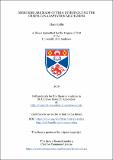Files in this item
Memories are made of this : investigating the CRISPR-Cas adaptation mechanism
Item metadata
| dc.contributor.advisor | White, Malcolm F. | |
| dc.contributor.author | Rollie, Clare | |
| dc.coverage.spatial | 241 | en_US |
| dc.date.accessioned | 2017-05-23T14:42:55Z | |
| dc.date.available | 2017-05-23T14:42:55Z | |
| dc.date.issued | 2017-06-21 | |
| dc.identifier.uri | https://hdl.handle.net/10023/10814 | |
| dc.description.abstract | CRISPR-Cas is an adaptive immune system unique to prokaryotes, which prevents infection by foreign genetic elements. Key to the function of CRISPR-Cas immunity is the ability to adapt to new threats in incorporating short segments, termed spacers, of invading DNA into the clustered regularly interspaced short palindromic repeat (CRISPR) array of the host. Spacers constitute immunological memories, used by CRISPR-associated (Cas) proteins to mount a sequence-specific attack on subsequent infections. The immunisation of the host is called CRISPR adaption. Adaption requires the integration of new spacers at a precise site in the CRISPR array. Two proteins, Cas1 and Cas2, are essential for adaptation; however, the mechanisms of spacer integration remain poorly understood. The work described here focused on understanding adaptation in Sulfolobus solfataricus. Using biochemical assays, I aimed to characterise the activity of the Cas1 and Cas2 proteins in this organism in order to understand their role in the insertion of new spacers. Additionally, I aimed to investigate how the expression of CRISPR-Cas components is regulated in this organism in response to viral infection. The results presented here show that expression of Cas1 was strongly upregulated in response to infection. A Csa3 protein from S. solfataricus was found to bind to the promoter for transcription of cas1, implying a role in the regulation observed. I reconstituted in vitro both the integration reaction performed by Cas1 and Cas2 proteins of S. solfataricus and the reverse of this reaction, disintegration. Cas1 was shown to impose sequence specificity on these reactions, selecting sites similar to the leader-repeat junction of the CRISPR locus. Finally, I demonstrated that, in addition to the intrinsic specificity of Cas1, there was a requirement for an additional host factor for site-specific integration in S. solfataricus. | en |
| dc.language.iso | en | en_US |
| dc.publisher | University of St Andrews | |
| dc.rights | Attribution-NonCommercial-NoDerivatives 4.0 International | * |
| dc.rights.uri | http://creativecommons.org/licenses/by-nc-nd/4.0/ | * |
| dc.subject.lcc | QH434.R76 | |
| dc.subject.lcsh | Prokaryotes | en |
| dc.subject.lcsh | Bacteria--Immunology--Genetic aspects | en |
| dc.subject.lcsh | Bacterial genetics | en |
| dc.title | Memories are made of this : investigating the CRISPR-Cas adaptation mechanism | en_US |
| dc.type | Thesis | en_US |
| dc.contributor.sponsor | University of St Andrews | en_US |
| dc.type.qualificationlevel | Doctoral | en_US |
| dc.type.qualificationname | PhD Doctor of Philosophy | en_US |
| dc.publisher.institution | The University of St Andrews | en_US |
The following licence files are associated with this item:
This item appears in the following Collection(s)
Except where otherwise noted within the work, this item's licence for re-use is described as Attribution-NonCommercial-NoDerivatives 4.0 International
Items in the St Andrews Research Repository are protected by copyright, with all rights reserved, unless otherwise indicated.


